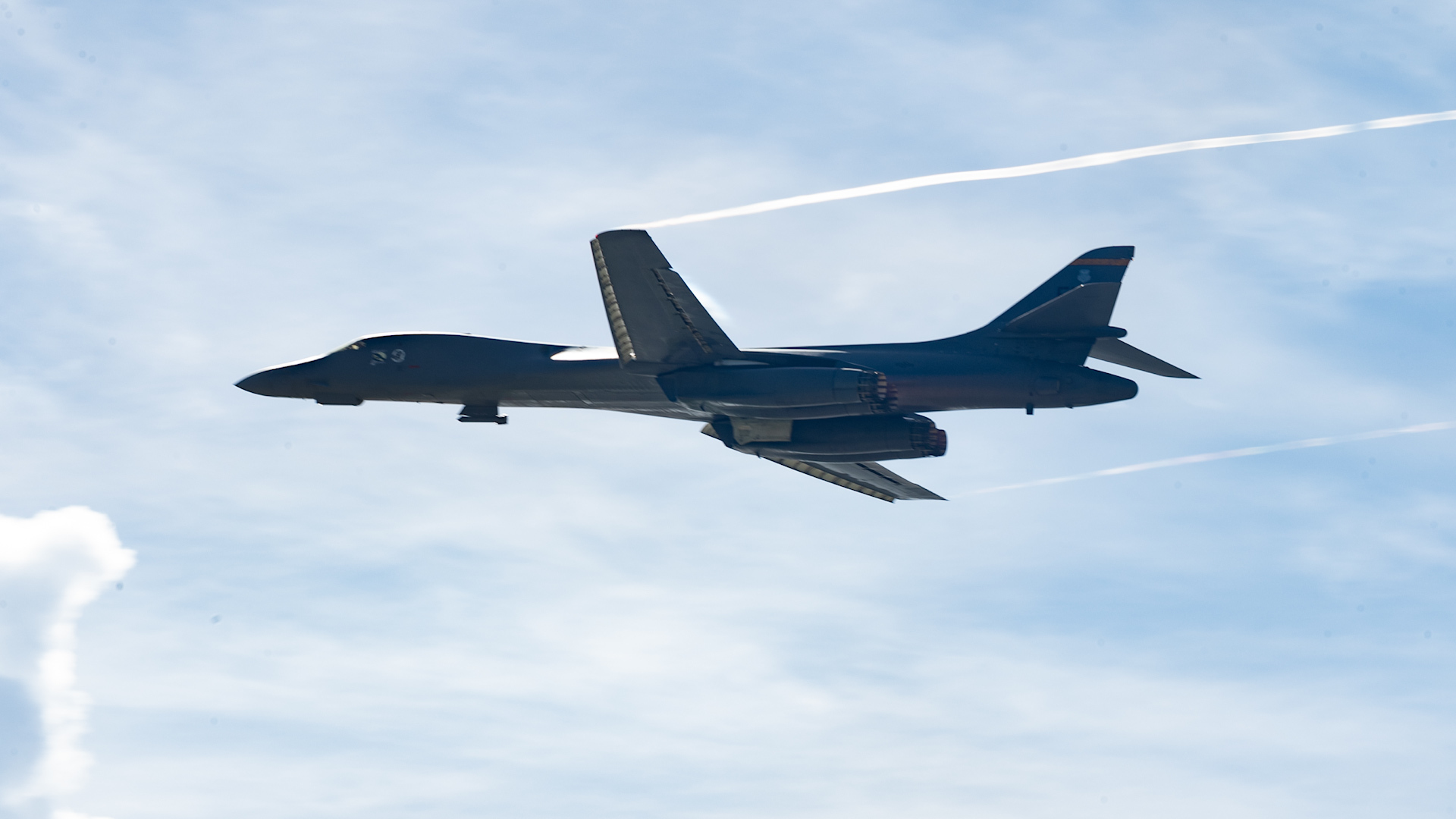
US brings out B-1B bomber after North Korea’s ICBM launch
By Ryan Robertson (Anchor), William Jackson (Producer), Jack Henry (Video Editor)
The United States deployed a B-1B Lancer, a supersonic heavy bomber, to Northeast Asia for a joint exercise with South Korea and Japan. The move is in response to North Korea’s recent test of a new intercontinental ballistic missile (ICBM) called the Hwasong-19.
Media Landscape
See how news outlets across the political spectrum are covering this story. Learn moreBias Distribution
Left
Right
Untracked Bias
North Korean leader Kim Jong Un personally observed the missile test, which reportedly has a range exceeding 9,300 miles, theoretically putting the U.S. mainland within reach. The missile set a new altitude record for North Korean launches, reaching approximately 4,350 miles—more than 17 times the height of the International Space Station.

Download the SAN app today to stay up-to-date with Unbiased. Straight Facts™.
Point phone camera here
In the joint exercise, the B-1B Lancer was joined by four Japanese F-2 fighters, four South Korean F-15Ks, and three U.S. F-16s stationed in South Korea. Originally capable of carrying nuclear payloads, the Lancer was converted to all-conventional strike missions in 2011. With a maximum payload capacity of up to 75,000 pounds, it remains the heaviest conventional bomber in the U.S. fleet.
🇺🇸 – 🇯🇵 – 🇰🇷 fighter aircraft escort a B-1 Lancer during a trilateral escort flight Nov. 3, 2024. This exercise continues strong trilateral cooperation, enabling immediate response to regional security challenges.
— U.S. Indo-Pacific Command (@INDOPACOM) November 3, 2024
Read More: https://t.co/bsjY65UcTE pic.twitter.com/m50DEosawP
The exercise demonstrated the collective strength and readiness of the U.S., South Korea and Japan, showcasing their commitment to regional security. South Korean officials described the B-1B’s presence as a display of “overwhelming” power and reiterated Seoul’s stance on close cooperation with the U.S. and Japan in addressing North Korean threats.
According to U.S. Indo-Pacific Command, the exercise supported a shared vision for a secure, rules-based Indo-Pacific region, showing the allies’ capability for rapid response to any security challenge. This deployment marks the fourth U.S. bomber mission in the region this year.
Get up to speed on the stories leading the day every weekday morning. Sign up for the newsletter today!
Learn more about our emails. Unsubscribe anytime.
By entering your email, you agree to the Terms & Conditions and acknowledge the Privacy Policy.
In June, a B-1B conducted a similar exercise, dropping live 500-pound bombs over the Korean Peninsula—the first live munition drop in the area by the Lancer in over seven years. In August, two B-1Bs flew a non-stop, 12,456-mile round trip from Ellsworth Air Force Base in South Dakota to Japan and back, completing the journey in approximately 31 hours.
[ryan robertson]
A UNITED STATES B-1B LANCER–A SUPERSONIC HEAVY BOMBER–
MADE A TRIP TO NORTHEAST ASIA FOR A JOINT EXERCISE WITH SOUTH KOREA AND JAPAN. THE EXERCISE WAS A RESPONSE TO NORTH KOREA’S RECENT TEST OF ITS NEW INTERCONTINENTAL BALLISTIC MISSILE DUBBED THE “HWASONG-19.”
NORTH KOREAN LEADER KIM JONG UN PERSONALLY OVERSAW THE TEST, AND REPORTS INDICATE THE MISSILE HAS A RANGE OF MORE THAN 9,300 MILES, THEORETICALLY ABLE TO REACH THE U.S. MAINLAND. THE REGIME ALSO SAID THE MISSILE SET A NEW ALTITUDE RECORD FOR NORTH KOREAN MISSILES, REACHING ABOUT 4,350 MILES—MORE THAN 17 TIMES HIGHER THANTHE INTERNATIONAL SPACE STATION.
FOR THE JOINT EXERCISE, THE LANCER WAS JOINED BY FOUR JAPANESE F-2 FIGHTERS, FOUR SOUTH KOREAN F-15K FIGHTERS, AND THREE U.S. F-16S THAT WERE STATIONED IN SOUTH KOREA. LANCERS WERE ORIGINALLY CAPABLE OF CARRYING NUCLEAR PAYLOADS–BUT THEY WERE CONVERTED TO ALL CONVENTIONAL STRIKE MISSIONS IN 2011. WHEN FULLY LOADED–LANCERS ARE CAPABLE OF CARRYING THE HEAVIEST PAYLOADS OF ANY BOMBER IN THE U-S FLEET–UP TO 75,000 POUNDS.
THE DRILL AIMED TO SHOW THE COLLECTIVE STRENGTH AND READINESS OF THE U.S., SOUTH KOREA, AND JAPAN, AS WELL AS HIGHLIGHT THEIR COMMITMENT TO REGIONAL SECURITY. SOUTH KOREAN OFFICIALS DESCRIBED THE B-1B’S PRESENCE AS A DISPLAY OF “OVERWHELMING” POWER, REAFFIRMING SEOUL’S STANCE ON WORKING CLOSELY WITH THE U.S. AND JAPAN TO ADDRESS NORTH KOREAN THREATS.
ACCORDING TO THE U.S. INDO-PACIFIC COMMAND, THE EXERCISE SUPPORTED A SHARED VISION OF A SECURE, RULES-BASED INDO-PACIFIC, DEMONSTRATING QUICK RESPONSE CAPABILITY TO ANY SECURITY CHALLENGES. THIS WAS THE FOURTH U.S. BOMBER DEPLOYMENT TO THE AREA THIS YEAR.
IN JUNE, A LANCER DROPPED LIVE 500-POUND bombs IN A SIMILAR EXERCISE OVER THE KOREAN PENINSULA, IT WAS THE FIRST TIME THE BOMBER DROPPED LIVE MUNITIONS IN THE REGION IN OVER SEVEN YEARS. AND IN ANOTHER CAPABILITY DEMONSTRATION IN AUGUST, TWO B-1BS FLEW A 12,456-MILE, NON-STOP ROUND TRIP FROM ELLSWORTH AIR FORCE BASE IN SOUTH DAKOTA TO JAPAN AND BACK, COMPLETING THE JOURNEY IN ABOUT 31 HOURS.
FOR MORE OF OUR UNBIASED, STRAIGHT FACT REPORTING – BE SURE TO DOWNLOAD THE STRAIGHT ARROW NEWS APP TODAY, OR LOG ON TO SAN.COM
Media Landscape
See how news outlets across the political spectrum are covering this story. Learn moreBias Distribution
Left
Right
Untracked Bias
Straight to your inbox.
By entering your email, you agree to the Terms & Conditions and acknowledge the Privacy Policy.
MOST POPULAR
-
 Getty Images
Getty Images
Democrats in Congress receive lowest approval rating in Quinnipiac poll history
Watch 2:5910 hrs ago -
 Getty Images
Getty Images
AG Bondi reviewing Epstein documents for release, could hold client list
Watch 1:4811 hrs ago -
 Getty Images
Getty Images
Speaker Johnson won’t support DOGE stimulus checks
Watch 2:0612 hrs ago -
 Reuters
Reuters
UN chief reveals his plan for peace in Haiti to Caribbean leaders
Watch 2:1514 hrs ago




